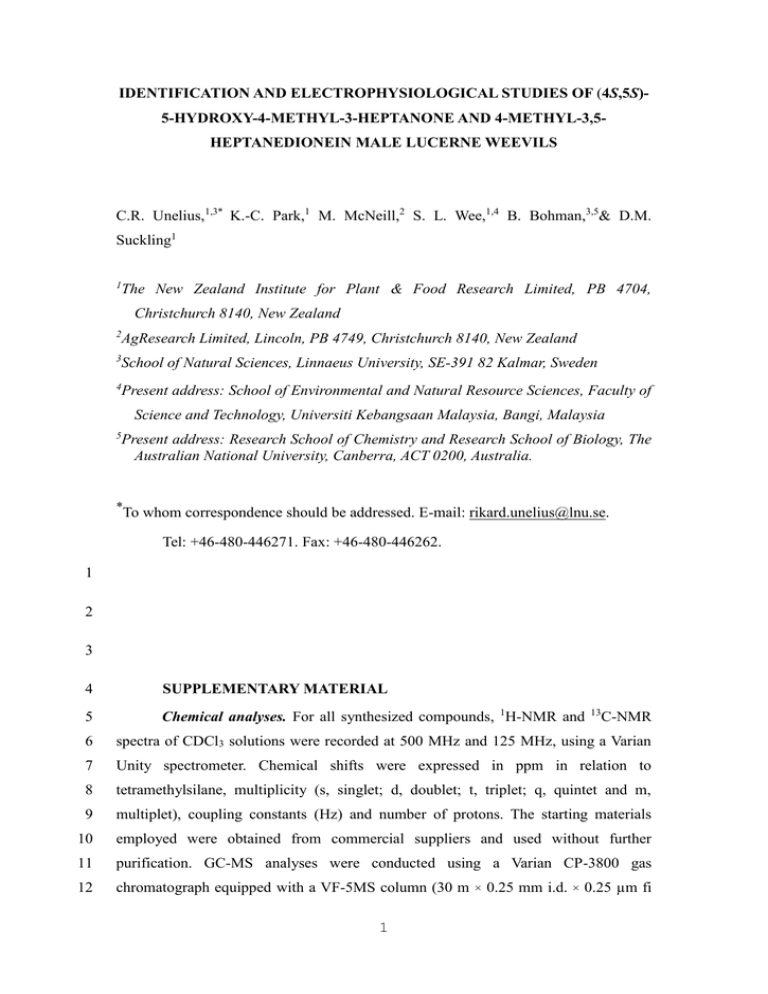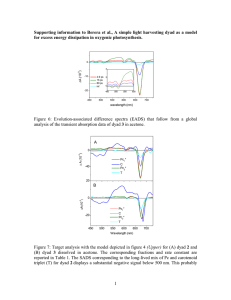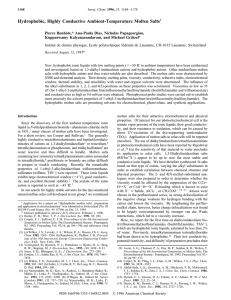Supplementary material - Springer Static Content Server
advertisement

IDENTIFICATION AND ELECTROPHYSIOLOGICAL STUDIES OF (4S,5S)5-HYDROXY-4-METHYL-3-HEPTANONE AND 4-METHYL-3,5HEPTANEDIONEIN MALE LUCERNE WEEVILS C.R. Unelius,1,3* K.-C. Park,1 M. McNeill,2 S. L. Wee,1,4 B. Bohman,3,5& D.M. Suckling1 1 The New Zealand Institute for Plant & Food Research Limited, PB 4704, Christchurch 8140, New Zealand 2 AgResearch Limited, Lincoln, PB 4749, Christchurch 8140, New Zealand 3 School of Natural Sciences, Linnaeus University, SE-391 82 Kalmar, Sweden 4 Present address: School of Environmental and Natural Resource Sciences, Faculty of Science and Technology, Universiti Kebangsaan Malaysia, Bangi, Malaysia 5 Present address: Research School of Chemistry and Research School of Biology, The Australian National University, Canberra, ACT 0200, Australia. * To whom correspondence should be addressed. E-mail: rikard.unelius@lnu.se. Tel: +46-480-446271. Fax: +46-480-446262. 1 2 3 4 SUPPLEMENTARY MATERIAL 5 Chemical analyses. For all synthesized compounds, 1H-NMR and 13 C-NMR 6 spectra of CDCl3 solutions were recorded at 500 MHz and 125 MHz, using a Varian 7 Unity spectrometer. Chemical shifts were expressed in ppm in relation to 8 tetramethylsilane, multiplicity (s, singlet; d, doublet; t, triplet; q, quintet and m, 9 multiplet), coupling constants (Hz) and number of protons. The starting materials 10 employed were obtained from commercial suppliers and used without further 11 purification. GC-MS analyses were conducted using a Varian CP-3800 gas 12 chromatograph equipped with a VF-5MS column (30 m × 0.25 mm i.d. × 0.25 µm fi 1 13 lm, Varian) and connected to an ion trap Varian Saturn 2200 MS with an electron 14 impact of 70 eV and source temperature of 250 oC. Injection volume was 1 µl in 15 splitless mode. The carrier gas was helium and the oven temperature was programmed 16 to increase from 40 oC (5 min hold) to 250 oC with 5 oC/min. Chemical identity of 17 volatiles from all treatments was confirmed by comparing the retention times and 18 mass fragment patterns with synthetic compounds. For enantioselective analyses, a 19 CYCLOSILcolumn (30 m × 0.25 mm i.d. × 0.25 µm film, J & W Scientific) and an 20 isothermal GC column temperature of 89 °C was used. All other conditions were 21 identical. 22 Synthesis of 4-methyl-3,5-heptanedione. Synthesis of 4-methyl-3,5- 23 heptanedione was based on a modification of a literature procedure (Kalaitzakis et al. 24 2006). A mixture of 3,5-heptanedione (6.0 g, 47 mmol), potassium carbonate (8.5 g, 25 62 mmol) and methyl iodide (6.65 g, 46 mmol) in acetone (15 ml) was heated to a 26 gentle reflux until GCMS analysis indicated that the reaction was completed (2 h). 27 The mixture was cooled to room temperature and acetone (200 ml) was added 28 followed by petroleum ether (100 ml). The solids were removed by filtration and the 29 solvents removed in vacuo. The crude product was purified by column 30 chromatography using 2% EtOAc in petroleum ether as eluant. The product was 31 obtained as colorless oil (4.2 g, 64%). The product consisted of a mixture of dione 32 and enol forms, the dione tautomer dominating (>10 times as abundant). GC-MS and 33 NMR data corresponded to literature data. GC-MS: 142(5), 114(5), 113(8), 86(45), 34 57(100) (Blight et al. 1984). 1HNMRδ: 3.68 (q, 1H, J=7.1 Hz), 2.49 (m, 4H), 1.31 (d, 35 3H, J=7.1 Hz), 1.04 (t, 6H, J=7.2 Hz), 13CNMR δ: 207.9, 60.5, 35.0, 13.1, 7.8 ppm 36 (Kalaitzakis et al. 2006). 37 38 39 Synthesis of 5-hydroxy-4-methyl-3-heptanone. Diisopropylamine (42 ml, 0.30 mol) 40 was dissolved in THF (100 ml). The stirred solution was cooled to 0°C and 41 butyllithium (2.5 M in hexane, 80 ml, 0.20 mol) was added dropwise over 20 min. 42 After 20 min of stirring at 0°C the temperature was lowered to -78°C and 3-pentanone 43 (21.0 ml, 0.20 mol) was added dropwise over 20 min. The mixture was stirred at -(70- 44 80)°C for 30 min before propanal (14.4 ml, 0.20 mmol) was added dropwise over 30 45 min and the reaction mixture was kept at the same temperature for 1 h. Then NH4Cl 2 46 (400 ml, sat., aq.) was added to the reaction mixture, which was allowed to warm to 47 RT. The aqueous phase was extracted 3 times with diethyl ether and the combined 48 organic phases were washed twice with brine and dried over MgSO4. Concentration in 49 vacuo gave a yellow oil of 95% purity (29.13 g, 96%). The product consisted of a 50 mixture of syn and anti isomers in a 3:2 ratio, the syn isomer dominating. 51 NMR data corresponded with published data (Kalaitzakis et al. 2006; Heathcock et al. 52 1979; Bohman et al. 2009). 1H-NMR δ: 3.82 (m, 1H, syn), 3.62 (m, 1H, anti), 2.43 - 53 2.67 (m, 3H), 1.41 -1.57 (m, 2H), 1.13 (d, 3H, J=7.2 Hz), 1.06 (t, 3H, J=7.2 Hz), 0.98 54 (t, 3H, J=7.4 Hz). 13C-NMR syn δ: 217.2, 72.8, 49.5, 35.3, 27.1, 10.6, 10.1, 7.8 ppm; 55 anti δ: 217.1, 75.2, 50.8, 36.3, 27.8, 14.5, 10.1, 7.8 ppm. GCMS: 126(15), 97(14), 56 86(37), 70(18), 69(11), 59(16), 57(100), 55(15). 57 58 59 60 61 62 63 64 65 66 67 68 69 70 LITERATURE CITED Kalaitzakis D, Rozzell JD, et al. (2006). Synthesis of valuable chiral intermediates by isolated ketoreductases: application in the synthesis of -alkyl--hydroxy ketones and 1,3-diols. Adv Synth Catal 348(14): 1958-1969 Heathcock CH, Pirrung MC, et al. (1979). Acyclic stereoselection. 4. Assignment of stereostructure to -hydroxycarbonyl compounds by carbon-13 nuclear magnetic resonance. J Org Chem 44(24): 4294-4299 Bohman B, Cavonius LR, et al. (2009). Vegetables as biocatalysts in stereoselective hydrolysis of labile organic compounds. Green Chemistry 11(11): 1900-1905 Blight MM, Pickett JA, et al. (1984). An aggregation pheromone of Sitona lineatus: identification and initial field studies. Naturwissenschaften 71(9): 480-480 3








